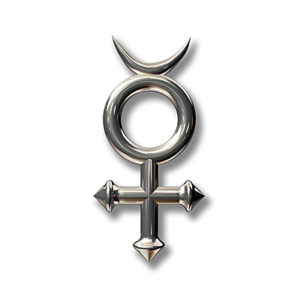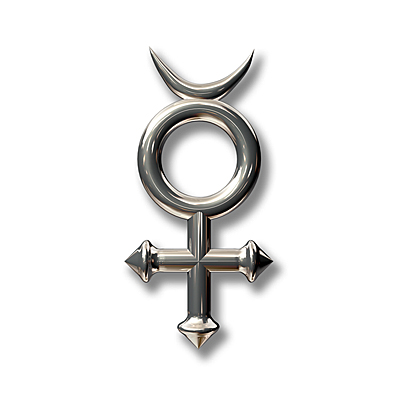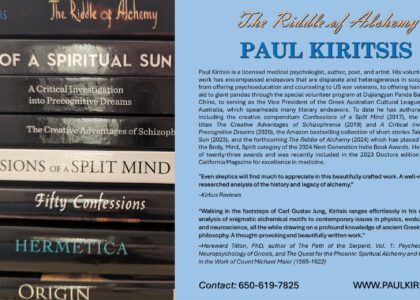
In contradistinction to the other four planetary forces and their metals which symbolise unique ruptures in the prima materia or first substance, the volatile and elusive mercurial power is a synonym for the entire cosmological process of becoming–in other words the coming-to-be of pure forms, of intellect or incarnated light from the receptive and creative mirror of the prima materia. Just look at corporeal mercury, a mysterious menstrual-like metal whose being and behaviour defy all logic. It is highly volatile and transformative, mobile and elusive in character, encompassing magical powers of amalgamation, separation and purification. Baffling to most is how mercury retains its indigenous state of repose as a liquid without losing density. This is truly a mystery! Together with the element of water, the metal in question can exist in three distinct states–as a liquid at room temperature, as a solid when the latter drops below 38.8 degrees Celsius, and as a gas when it exceeds 356.73 degrees Celsius. These unique chemical properties no doubt motivated esotericists to conclude that its ethereal counterpart was an explicit expression of the prima materia as the androgynous autogenerator of gold and all other metals. Just as corporeal mercury could liberate pure gold from its quartz matrix, so too does ethereal mercury extract the vital breath or sulphurous fire of spiritual gold from the cosmic sea of life. This conviction, primordial in age, was held by a vast majority of alchemists. In fact it was the primum agens of their lifelong plight.
Only in the mobile and vital mercurial force do we find the solar and lunar principles along with the four elements reconciled and cohabiting the same cosmological condition like a synthesis of body, soul and spirit, all of which are eternal determinants and arrangers of the human being. The esoteric symbol for this quality, comprised of geometrical shapes like the circle, the semicircle and the cross, definitely corroborates its inherent nature. Those tutored to the language of alchemy should be able to discern the entirely volatile condition of the mercurial spirit in the arrangement of the shapes themselves. The four ethereal elements of fire, air, water and earth are grounded, crystallized into two elemental couplets by the dry, masculine and seedy solar force fixed directly above it. The presence of the solar principle or aspect betrays ontological potential for manifold forms in the manner that a eucalyptus seed contains within itself the Platonic form of a eucalypt as well as its culmination. But in mercury one can see that the circle is capped by a semicircle, meaning that the solar principle or active force is predominated by the lunar principle or passive force. Confidentially the symbol is merely transcribing a state of being in which all forms of matter that have been, are coming to exist or will exist in the future coexist as germs in the prima materia. It is also asserting that mercury is the menstruum or womb of all formative forces that garner active or passive expression through their associate planets and metals. The potential for differentiation and development is undoubtedly there, but as the symbol suggests, the inertia of receptivity has not yet been overcome.
Nowhere has the metal enjoyed a more vibrant career than in China, India and Tibet. In those parts of the world cinnabar–the mercurial ore or sulphide–was usually cooked on an iron saucer to liberate the quicksilver. Iron was used as a medium given that it was the only metal known that resisted dissolution when exposed to metallic mercury. Once reduced to quicksilver, it was used for therapeutic purposes such as accelerating the healing of wounds and prolonging life indefinitely, or so they thought. This rudimentary process for liberating volatile from fixed substances, otherwise known as distillation, was to become foremost of the chemical operations carried out in laboratory settings when it diffused into the consciousness of Alexandrine alchemists centuries afterward. On another note the ancients were somewhat mistaken in their beliefs; they were convinced that the red sulphide ore of mercury known as cinnabar and the red calx or mercuric oxide which was obtained by heating it were one and the same substance. Hence many alchemists were able impress their incredulous audiences with a chemical recipe in which the metal’s reactions were shown to be reversible; when subjected to a continual cycle of sublimations, the metal passed through manifold transformations before seemingly reacquiring to its indigenous, preheated state as cinnabar.
Recipes reciting the preparation of quicksilver extend back to at least the second century ce, though it probably wasn’t until the Arab conquests of the seventh century ce that a full-fledged investigation into the properties of the metal were conducted. Under the auspice of a progressive and intellectual climate, the prominent Arab alchemist Jabir ibn Hayyan (c. 721-815ce) took chemico-operative and practical alchemy to an unprecedented level. Besides introducing innovations to existing laboratory apparatus, pioneering in the fabrication of certain acids and tinctures and implanting novel theoretical premises into the dual art, Jabir described the chemical processes through which cinnabar was reduced to red calx or mercuric oxide as well as the preparation of mercury perchloride through sublimation. Moving the intense focus away from the four ethereal elements, he also inaugurated the Sulphur-Mercury theory into alchemical dogma. According to this cosmological schema, the four ethereal elements of the initial rupture segregate into two philosophical principles, Mercury and Sulphur. In turn the polarisation of the two principles spurs inimitable combinations and stellar arrangements in the four elements and in one another, which in turn gives rise to all earthly metals under the aegis of the seven planetary powers. Roughly eight centuries after the life and times of Jabir, Swiss physician and alchemist Paracelsus of Hohenheim (1493-1541ce) added a third principle to the Mercury-Sulphur theory, that of Salt. He also rendered a practical use for the salts of mercury, administering minute quantities to his patients’ wounds and burns to accelerate the healing process or alternatively disinfect them.








